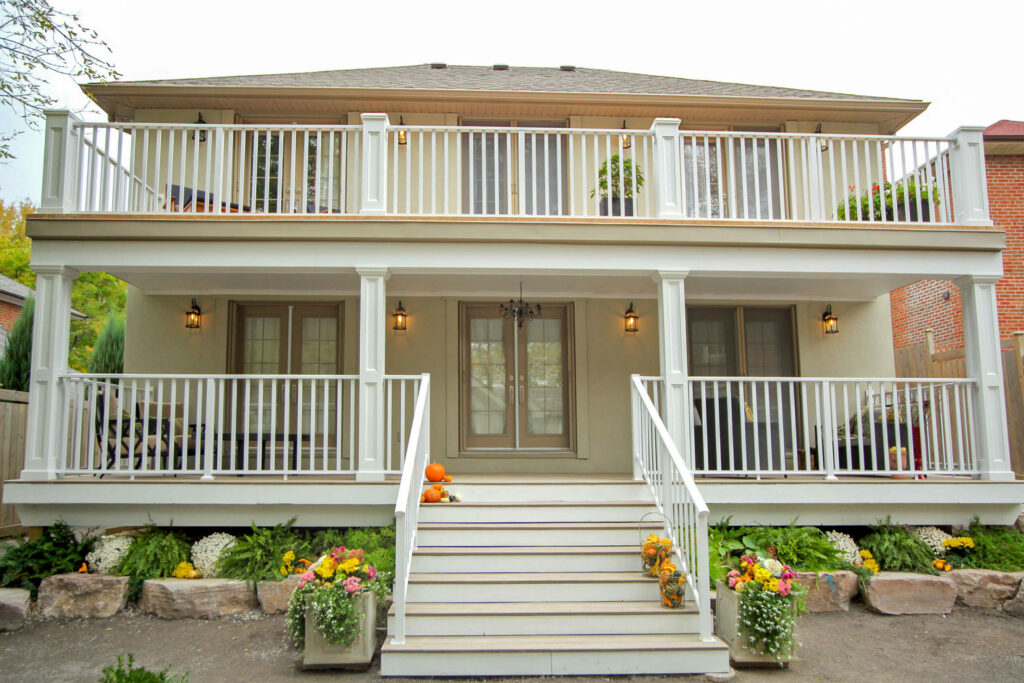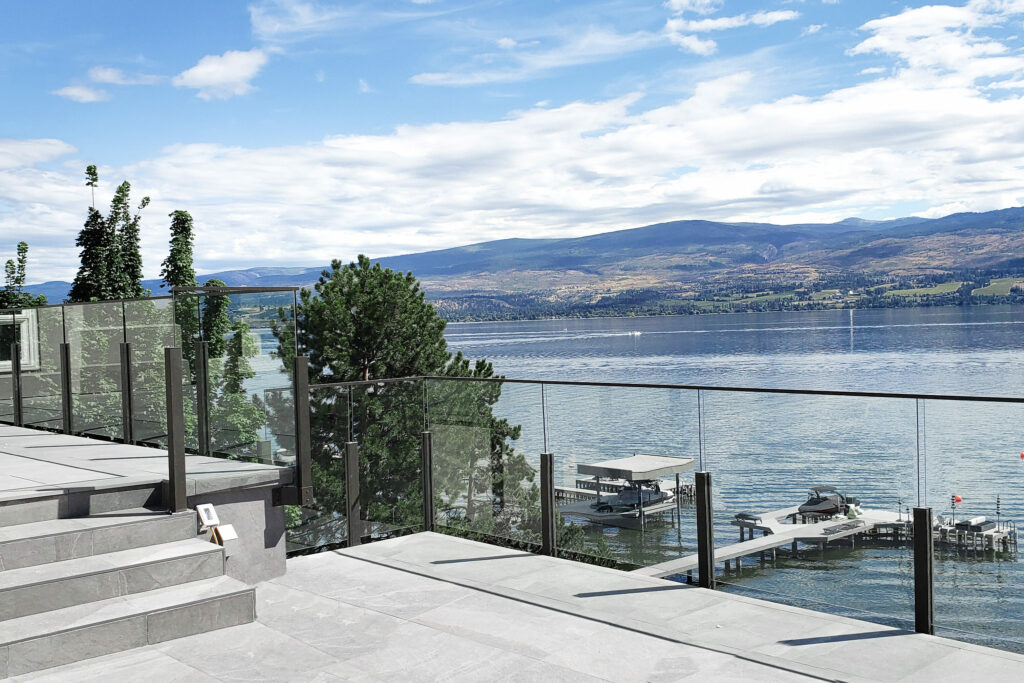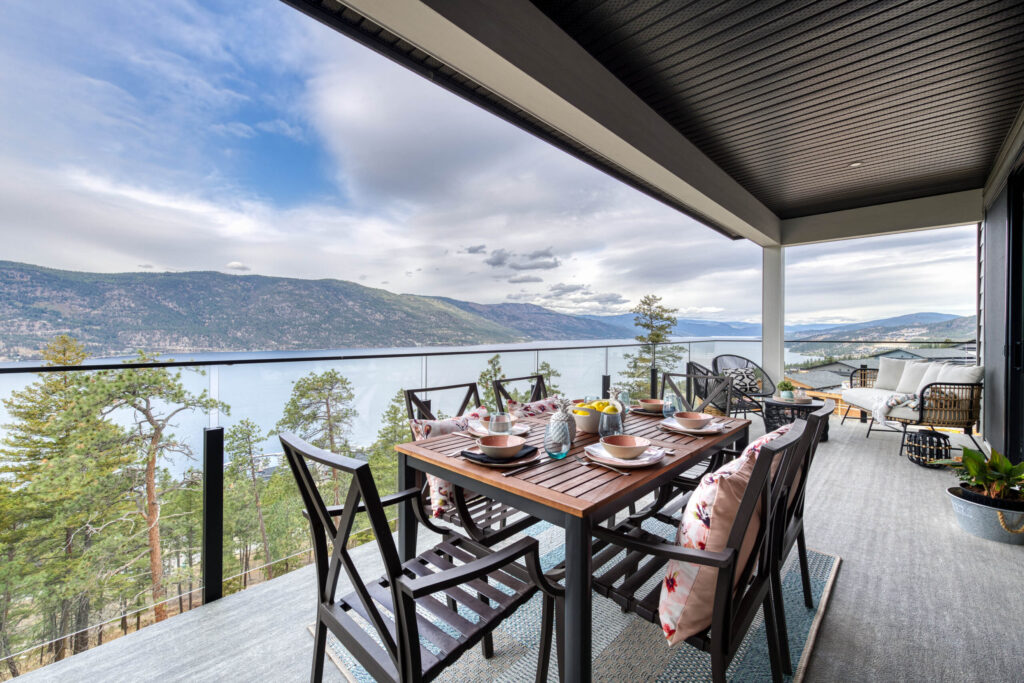Deck railings are an ideal addition to any outdoor space, and a surefire way to boost the appeal of your home. They not only add an aesthetic flair, but they act as a crucial element in the overall safety and functionality of your space.
When it comes to selecting the right material for your deck railings, the decision between aluminum vs steel is significant. The main factors you need to consider are cost, durability, maintenance needs, design aesthetics, and your local climate conditions.
At Deksmart, we know how important it is for homeowners to make the best possible decisions about their home.
This blog explains the key differences between steel railing systems and aluminum railing systems, along with some of the competitive advantages aluminum deck railings offer home and building owners.

Corrosion & Weather Resistance
Durability is a key factor to consider when you’re considering deck railing options. While both steel and aluminum have the capacity to hold up against extreme conditions, there are a couple key differentiators that would rank aluminum superior here.
Steel
While it’s often known for its ultra durable components, steel railings can be more susceptible to corrosion than aluminum railings over time—especially when exposed to moist and harsh weather conditions. The oxidization process that takes place long term can lead to rust formation, which can compromise the overall structure of the railing.
Steel is also known to have a critical point of failure around temperatures of -40°C. If you live in a climate with harsh winters, steel railings can become brittle, causing damage to your railings’ structural integrity.
Aluminum
This element on the other hand, boasts a natural corrosion resistance that holds up against the harshest conditions, including extreme cold, high humidity, and extreme heat.
What makes aluminum corrosion resistant is its ability to naturally form a thin oxide layer on its surface when exposed to oxygen. This oxide layer acts as a protective barrier, preventing further corrosion or rusting.
At Deksmart, all of our aluminum railings come with a powder coated finish that adds an extra layer of protection against corrosion and long term color retention.
In addition to its natural resistance to elements, aluminum is known to actually strengthen in even the coldest of climates. This is because of the face-centred cubic crystal structure of aluminum, otherwise known as FCC. The structure of aluminum has very little sensitivity to changes in temperature, and therefore does not affect its yield strength.
Aluminum is also UV resistant, making it highly durable under prolonged exposure to sunlight. This kind of durability ensures that the railing retains its color over time and doesn’t suffer from degradation due to sun exposure.
Strength & Weight
When comparing aluminum and steel, aluminum undoubtedly makes for a more lightweight, easy to install option for deck railings. The strength to weight ratio of aluminum is approximately 2.8 times better than steel, boasting a specific strength of around 260 megapascals per cubic meter (MPa/m³).
To compare, common structural steel has a specific strength of approximately 179 MPa/m³, which indicates that lightweight aluminum has a stronger strength to weight ratio than steel.
Since aluminum is leightweight and easy to cut, installing aluminum railings is easy as a contractor or a DIY homeowner.
Steel, on the other hand, really excels in industrial settings where load-bearing capacity is a high priority. With a density boasting 2.5-3 times greater than aluminum, steel offers superior strength and resistance to high heat & heavy loads. While steel and stainless steel excel in some industrial settings, it’s not necessarily the best choice when it comes to your home’s deck railings.

Cleaning & Maintenance
Easy cleaning and maintenance is one of the reasons many homeowners choose aluminum railings, which require minimal upkeep and can continue looking new with some simple regular weekly cleaning practices.
Aluminum in Hot & Cold Temperatures
Aluminum, being a softer metal, exhibits a phenomenon known as linear expansion and contraction in response to temperature variations. This means that as the temperature increases, the aluminum material expands linearly, and conversely, it contracts when the temperature decreases.
With aluminum railings, you may need to retighten your mounting post screws after cold winters to ensure the structural integrity and stability of the railings. Being proactive is key here, and contributes to the overall maintenance and durability of your deck railings.
Compared to aluminum, stainless steel railings can be more challenging to maintain because steel is more prone to rusting. If you pick steel railings, you may need to clean them with a rust removing solution (baking soda, vinegar and water can often work) and scrub them down with a wire brush – a time and labor intensive process.
Steel may also require more regular painting in order to further protect from the elements. This can result in higher costs for upkeep, and also be taxing time wise. It’s important to note that rust spots on steel will need to be carefully cleaned, and proper surface preparation is essential before repainting.
Design & Style
One of the more appeal boosting qualities of aluminum railings is the option for powder coated finish. Powder coating allows for a broader range of color options due to its unique application process which involve finely ground pigment particles. This is unlike traditional liquid paints, which can have limitations in achieving certain hues.
In addition to more colour options, aluminum’s malleability allows for a wide range of unique design possibilities, whereas steel’s higher density and weight make it less malleable and more challenging for intricate patterns and design. For example, the strength and rigidity of steel call for more structural support, making it more difficult to implement things like ornamental styles or top bar styles.
Comparing the Costs of Aluminum & Steel Railings
While aluminum may have a higher initial cost, its superior weather and corrosion resistance makes it a better long-term investment for homeowners, resulting in lower upkeep costs and a longer product lifespan.
Aluminum’s long-lasting durability ensures a sustained aesthetic and lasting structural integrity. Overall, aluminum railings are a cost-effective and sustainable choice for contractors and homeowners seeking a low-maintenance railing solution.

Climate Considerations: Steel Railings vs Aluminum Railings
Depending on where you live, you’ll want to consider which deck railing option will best suit your home’s climate conditions. For example, steel may be the more optimal choice for coastal areas, while aluminum shines in colder climates and high-UV areas. When choosing which material serves your home best, consider tailoring your choice to the following analysis:
Coastal Climates:
- Steel: In this scenario, steel fares better due to its’ high resistance to salt damage.
- Aluminum: Because this material is more prone to salt damage, at Deksmart, we offer a Limited Warranty for any product that resides within one mile of coastal water.
Cold Climates:
- Aluminum: With high ductility and unique ability to strengthen in cold climates, aluminum railings are a better investment for buildings in colder climates like the Canadian prairies.
- Steel: Due to its critical point of failure around -40°C, steel can become extremely brittle and prone to damage in colder climates.
High-UV Climates:
- Powder Coated Aluminum Railing: The powder coat finish on aluminum railings provides excellent UV resistance, preventing the material from fading, chipping, or peeling due to prolonged exposure to sunlight. This is crucial in high UV environments where constant sun exposure can lead to degradation. Aluminum also dissipates heat faster, keeping your railings nice and cool in the summertime.
- Steel: Because steel tends to absorb and retain heat in high-UV environments, this can result in steel railings becoming uncomfortably hot to the touch, potentially posing safety concerns for users.
Highrise Building Considerations:
- Aluminum: Because of its lightweight properties, aluminum makes it easy to transport and install in high-rise buildings. It’s also more advantageous in coastal regions where the high-rise building may be more prone to saltSteel:
- Steel: Known for its strength and durability, this can be advantageous in high-rise structures where structural integrity is crucial.
Recyclability of Aluminum vs Steel
Aluminum railings outshine steel counterparts with superior recyclability. Aluminum boasts a closed-loop recycling capability, allowing it to be repurposed without losing integrity, reducing the need for primary extraction. The recycling process consumes less energy compared to steel, making aluminum railings an environmentally responsible choice.
In Summary: Aluminum Railing vs Steel Railing
Overall, the choice between steel and aluminum railings will depend on the homeowners specific considerations. Factors such as: climate conditions, installation requirements, cost, maintenance, and overall structure and durability are key to consider when making an informed choice.
While steel may fare as the better choice for industrial settings and coastal regions, low maintenance aluminum railings really shine in cold climates, high UV environments, and residential settings.
At Deksmart, we’re happy to offer the highest quality, Canadian made Glass & Aluminum Railing Systems to best suit your outdoor space.
We also offer a Limited Warranty, an easy, DIY home installation process, and have everything made to company code, conveniently available at distributors across North America. To learn more about our wide range of products and services, visit our website today and locate your nearest dealer!
- Related content:
